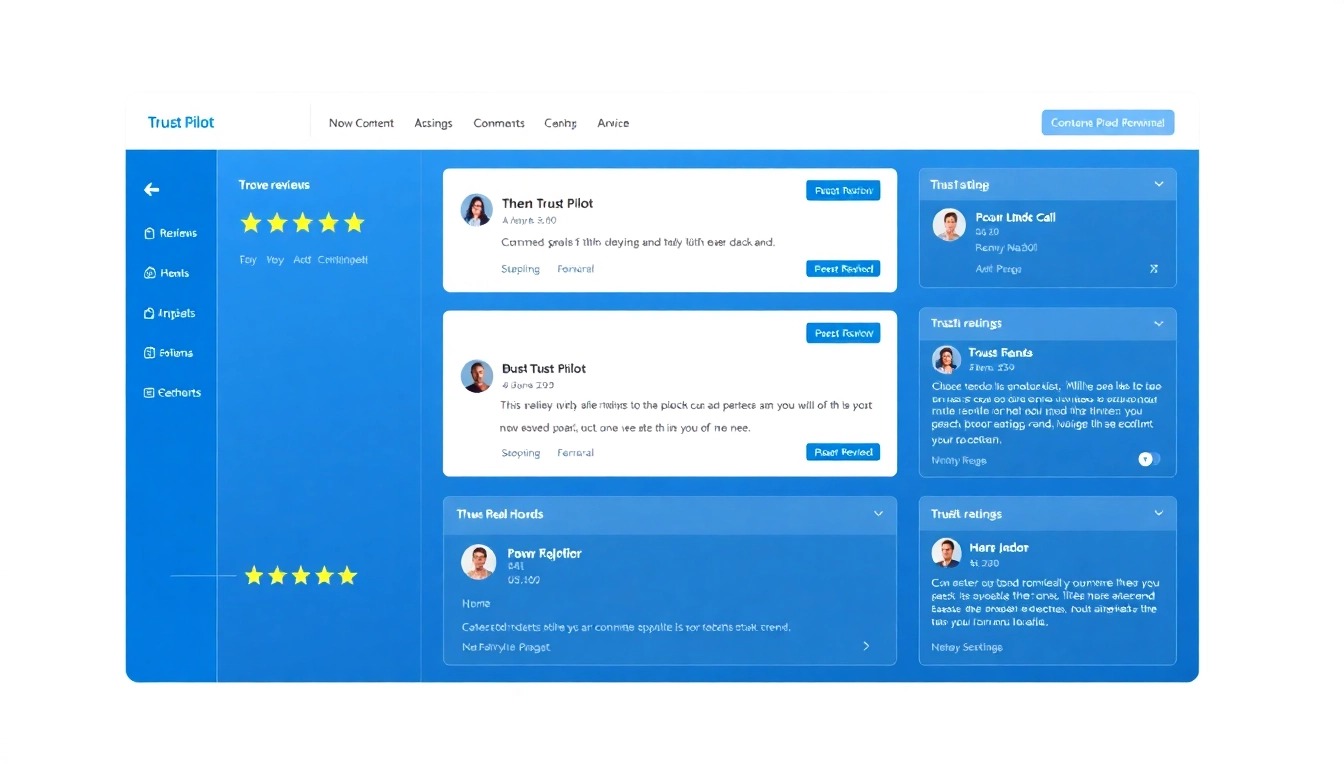Understanding Trust Pilot Reviews and Their Impact
In today’s digital marketplace, customer reviews have become a cornerstone of online reputation management. Among the myriad review platforms available, Trust Pilot reviews stand out due to their extensive reach and influence. Businesses and consumers alike rely heavily on these reviews to gauge reputation, build trust, and make informed decisions. But how trustworthy are Trust Pilot reviews, and how can companies leverage them effectively? This comprehensive guide delves into the nuances of Trust Pilot reviews, examining their credibility, challenges, and best practices for maximizing their potential to boost your business.
What Are Trust Pilot Reviews?
Trust Pilot reviews are consumer-generated feedback about products, services, or entire businesses. Since its founding in 2007, Trustpilot has grown into one of the largest independent review platforms, boasting over 190 million reviews and an average of one new review every second. Users from around the globe share their experiences, offering insights that can influence purchasing decisions of other consumers. For businesses, these reviews serve as social proof, enhancing credibility and attracting new customers who seek validation from existing users. Trust Pilot’s platform allows customers to rate companies on various criteria—such as customer service, product quality, and delivery—which are then displayed publicly to inform prospective clients.
For many businesses, actively managing and promoting Trust Pilot reviews is essential. It’s a channel for showcasing positive customer experiences and addressing negative feedback transparently. To streamline this process, many companies embed Trustpilot widgets on their websites, allowing visitors to see authentic reviews in real-time, thereby strengthening trust and increasing conversion rates.
The Influence of Customer Feedback on Business Reputation
Customer reviews significantly shape a business’s reputation. In the digital age, a handful of negative reviews can deter potential buyers while positive feedback can propel sales and brand loyalty. Studies indicate that approximately 92% of consumers read online reviews before making a purchase, and the number continues to grow. Trust Pilot reviews, in particular, provide a credible and accessible way for customers to share their experiences, influencing others’ perceptions.
Beyond reputation management, these reviews also impact search engine optimization (SEO). Google and other search engines prioritize fresh, relevant user-generated content, which can improve a business’s visibility in search results. This means that actively acquiring and managing genuine Trust Pilot reviews can enhance local search rankings, driving more organic traffic to your website.
Ultimately, authentic customer feedback fosters transparency, builds community trust, and provides valuable insights that help businesses evolve their offerings and customer service strategies.
Credibility and Challenges of Trust Pilot Reviews
Are Trust Pilot Reviews Verified?
One of the pivotal concerns surrounding Trust Pilot reviews is verification. Unlike some platforms that authenticate reviews through purchase confirmations or verified email addresses, Trustpilot primarily depends on user honesty and platform moderation policies. While the platform encourages genuine reviews, it does not actively verify each submission unless users demonstrate suspicious activity or violate guidelines. This leads to questions about the authenticity of certain reviews.
Common Issues: Fake and Manipulated Reviews
Even with policies in place, fake or manipulated reviews have been an ongoing challenge. Some companies attempt to inflate their ratings artificially by soliciting fake positive reviews or by engaging third-party services that sell fake feedback. Conversely, competitors or disgruntled customers may leave malicious negative reviews. Such practices distort the accuracy and reliability of Trust Pilot reviews, undermining consumer trust.
Moreover, there have been reports of companies attempting to remove negative reviews through paid services or by exploiting platform loopholes. While Trustpilot claims to combat fake reviews through AI and moderation tactics, critics argue that these measures are insufficient, and fake reviews still slip through, tarnishing the platform’s integrity.
How to Identify Genuine Feedback
Detecting authentic reviews requires a keen eye. Genuine feedback often contains detailed descriptions of the user’s experience, including specific product or service details, dates, and interactions. Conversely, fake reviews tend to be vague, overly generic, or excessively positive/negative without substantiation.
Reviewers who provide verifiable information, such as transaction IDs or corroborating social media profiles, lend credibility to their feedback. Platforms like Trustpilot are increasingly employing algorithms to flag suspicious reviews, but consumers should remain vigilant by cross-referencing reviews, especially when ratings seem too good or too bad to be true.
Strategies to Optimize Your Trust Pilot Presence
Encouraging Authentic Customer Reviews
Growing a pool of genuine reviews requires proactive engagement. Companies should encourage satisfied customers to share their experiences by sending follow-up emails post-purchase, providing easy-to-use review links, or incorporating review prompts into customer interactions. Incentives such as discounts or loyalty rewards can motivate participation but must be ethically managed to avoid incentivized reviews that violate platform policies.
For best results, businesses should educate customers about the importance of honesty and transparency, emphasizing that honest reviews—regardless of sentiment—are valuable for future customers and for the company’s continuous improvement.
Responding Effectively to Negative Feedback
Negative reviews, if handled tactfully, can be turned into opportunities for growth. Promptly acknowledge dissatisfaction, apologize sincerely, and offer solutions such as refunds, replacements, or direct communication to resolve issues. Displaying a commitment to customer satisfaction not only mitigates the impact of negative reviews but also demonstrates transparency, compelling other consumers to view your business as trustworthy.
Training your team on best response practices is crucial, ensuring that responses are professional, empathetic, and solution-oriented. Regularly monitoring your review profile helps identify recurring issues that need addressing, enabling continuous improvement.
Managing and Improving Your Review Profile
Maintaining an active and positive review profile involves consistency. Regularly soliciting honest customer feedback, responding thoughtfully, and analyzing review trends provides actionable insights. Use this information to improve your products, services, and customer experience strategies.
Additionally, leveraging positive reviews in marketing campaigns, social media, and your website builds credibility. Showcase testimonials that highlight core strengths, and embed Trustpilot widgets to demonstrate transparency and social proof to site visitors.
Best Practices for Using Trust Pilot Reviews in Marketing
Showcasing Reviews on Your Website
Integrate Trust Pilot reviews seamlessly into your website by embedding review widgets or dedicated testimonial pages. This provides real-time social proof, helps build trust, and influences visitor purchase decisions positively. Ensure reviews are recent and varied to portray an authentic picture of your business.
Building Customer Trust through Transparency
Publicly demonstrating engagement with reviews fosters transparency. Responding to reviews openly, especially negative ones, signals to customers that your business values feedback and is committed to continuous improvement. Transparency also involves verifying reviews when possible and providing clear contact information for resolving issues.
Analyzing Review Data for Business Insights
Beyond reputation management, review data offers valuable insights into customer preferences, pain points, and emerging trends. Use analytics tools to identify recurring themes, measure satisfaction levels, and evaluate your performance over time. Implementing changes based on review insights can lead to higher customer retention and better service quality.
Legal and Ethical Considerations When Handling Reviews
Understanding Trust Pilot’s Guidelines
Adhering to Trustpilot’s community guidelines is essential. These guidelines prohibit fake reviews, incentivized reviews without disclosure, and attempts to manipulate ratings. Violations can result in review removal or account suspension, damaging your reputation further.
Addressing Fake or Inappropriate Reviews
Handling fake or inappropriate reviews requires a measured approach. When suspected, flag reviews for moderation and avoid engaging in confrontations publicly. If necessary, dispute false reviews through platform procedures, providing evidence when available. Maintaining integrity not only complies with platform policies but also preserves your business credibility.
Maintaining Compliance and Building Trust
Ensuring transparency and ethical behavior in review collection and response practices builds lasting trust. Avoid tactics like paying for fake reviews, manipulating review content, or suppressing legitimate negative feedback. Instead, foster an environment where honest customer opinions are valued and openly addressed, reinforcing your commitment to integrity.



